What is plantar fascitis?
 |
| Source : www.patient.co.uk |
One of the most common causes of heel pain is plantar fascitis. This condition occurs because of micro trauma and inflammation to the plantar fascia. The result is inflammation of the fascia casing aching pain, as well as swelling and bruising.
The plantar fascia is a thick fibrous band of tissue on the bottom of the foot. It runs from the heel to the base of the toes. It also acts like a rubber band to create tension and maintain the arch of the foot.
What are the Symptoms of Plantar Fascitis?
-
Typically the pain of plantar fascitis is very sharp and located at the base of the heel and can also spread throughout the length of the foot.
-
Pain can be most severe in the mornings on getting out of bed and when you take your first step after long periods of rest with initial weight bearing of the foot.
-
You may also experience swelling, tenderness on deep touching the plantar fascia (often on a specific spot on the inner aspect of the heel).
-
Gentle exercise may ease things a little as the day goes by, but a long walk or being on your feet for a long time often makes the pain worse.
-
Resting your foot usually eases the pain.
-
Sometimes pain is experienced when performing a plantar fascia stretch.
-
You may walk with a limp or be unable to weight bear on the affected leg.
What Causes Plantar Fascitis?
You are more likely to injure your plantar fascia in certain situations. For example:
-
If you do lots of walking, running, standing (more than 1 hour of continous activites).
-
If you have a poor foot posture (especially flat feet. Feet which rotate too far inwards or high arches).
-
If you have a foot or ankle stiffness.
-
If you have muscle weakness (particularly the calf)
-
If there is overuse or sudden stretching of your sole. (Inappropriate or excessive training. Example: athletes who increase running intensity or distance).
-
If you have a tight muscles (particularly in the calf). This can affect your ability to move your ankle and make you more likely to damage your plantar fascia).
-
If you are overweight (this will put extra strain on your heel).
-
If you have leg length differences.
-
If you have been wearing shoes with poor cushioning or poor arch support (avoid loose, thin-sole shoes)
Who is prone to plantar fascitis?
It was estimated around 1 in 10 people will get plantar fasciitis in United States in their lifestyle. It is twice as common in women than men. It is also common in athletes. It is most common in people between the ages of 40 to 60 years.
What are the complications if plantar fascitis is not treated?
Ignoring plantar fascitis may result in chronic heel pain and significantly impact a person’s daily lifestyle.
You may also develop foot, knee, hip or back problems because of the way plantar fascities changes your walking.
Physiotherapy Treatment
Physiotherapy treatment is vital to hasten the healing process, ensure an optimal outcome and reduce the likelihood of recurrence.
Physiotherapy will assess and evaluate your leg, help you to relieve the pain, increase muscle flexibility, increase your muscle strength, also help you to plan your gradual return to activity as symptoms go away.
Treatment may comprise:
-
Ice or heat treatment.
-
Electrotherapy (eg. Ultra sound).
-
Exercises to improve balance, strength and flexibility (particularly of the calf muscles).
-
Soft tissue massage.
-
Joint mobilization.
-
Taping.
-
Education (foot wear and activity modification).
Exercise for Plantar Fascitis
Calf stretches
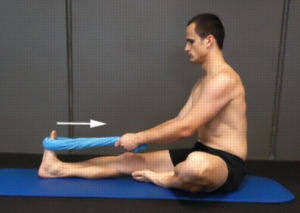 |
| Source : www.physioadvisor.com.au |
|
 |
| Source : www.uwhealth.org |
|
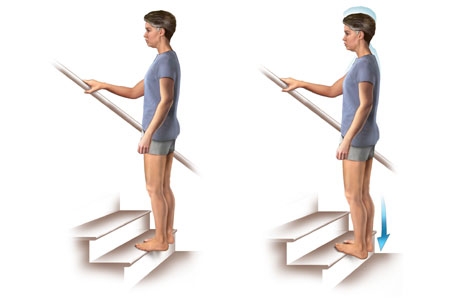 |
| Source : www.bridgerridgerun.worldpress.com |
|
Plantar fascia stretches
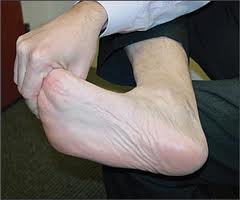 |
| Source : www.myplantarfascitis.com |
|
Calf Strengthening exerices
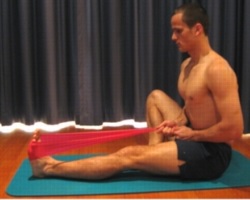 |
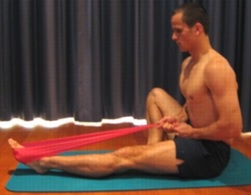 |
| Source : www.physioadvisor.co.au |
|
Summary
-
Try the exercises suggested here to help ease pain and prevent future injuries.
-
Your pain should ease within 2 weeks and you should recover over approximately 4-6 week period.
References
-
Renan-ordine R et al (2011). Effectiveness of myofascial trigger point manual therapy combined with a self-stretching protocol for the management of plantar heel pain; A randomized controlled trial. J Orthop Sports Phys Ther..
-
Scher DL, Belmont PJ Jr bear R et al (2009). The incident of plantar fascitis in the United States Military J Bone Joint Surg Am
-
May T, Judy T, Contim (2002). Current treatment of plantar fasciitis. Current sport medicine reports. Retrieved Julai 4, 2013 from http://www.dubinchiro.com/plantar pdf
-
Cole c , Se To C , Gazewood J (2005). Plantar fascitis. Evidence based review of diagnosis and therapy. American family physician.
-
Barrett SJ, O Malley R (1999). Plantar Fascitis and other causes of heel pain. American Family physician.
Source of images
-
Dr Suite (2013) . Plantar fascitis retrieved July 4 from http://www.sdri.net
-
David Siawson (2013): Plantar fascitis; evidence-based review of diagnosis and therapy.retrieved July 4 , 2013 from http://www.aafp.org
-
Dr Tim Kenny (2013). Plantar fascities. Retrieved July 4 , 2013. From http://www.patient.co.uk
-
Bridger ridge run (2011). Plantar fascitis: prevention, treatment and healing technique. Retrived July 4, 2013. From http://bridgerridgerun.wordpress.com
-
(2011). Understanding my plantar fascitis symptom. Retrieved July 4,2013.from www.myplantarfasciitis.com
-
www.physioadvisor.com.au
| Last Reviewed | : | 23 August 2019 |
| Writer | : | Se To Phui Lin |
| Accreditor | : | Daaljit Singh |
| Reviewer | : | Halimah bt. Hashim |







